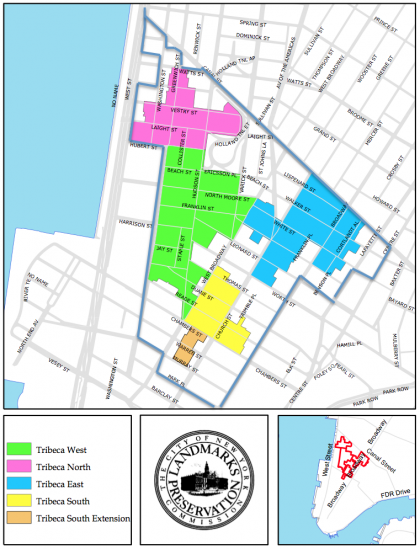Should Tribeca’s Historic Districts Be Expanded?
 “The original request of the Tribeca community in 1988 was for a single large historic district,” emailed Tribeca Trust founder Lynn Ellsworth. “Instead, we got four smaller districts with jagged edges and spaces between, as many buildings, lots, and blocks were left out. Over time we have seen the consequences of this kind of gerrymandering and ‘under-designation’ of Tribeca: the steady erosion of the historic character of both the undesignated parts of Tribeca and those designated parts that are near the jagged edges. We have asked the Landmarks Preservation Commission to consider new boundaries that make Tribeca whole again. If the present commission fails to act, we will ask again under the next city administration.”
“The original request of the Tribeca community in 1988 was for a single large historic district,” emailed Tribeca Trust founder Lynn Ellsworth. “Instead, we got four smaller districts with jagged edges and spaces between, as many buildings, lots, and blocks were left out. Over time we have seen the consequences of this kind of gerrymandering and ‘under-designation’ of Tribeca: the steady erosion of the historic character of both the undesignated parts of Tribeca and those designated parts that are near the jagged edges. We have asked the Landmarks Preservation Commission to consider new boundaries that make Tribeca whole again. If the present commission fails to act, we will ask again under the next city administration.”
The map above shows the current districts and, in thicker blue line, where Tribeca Trust would like them to be.
The group is skeptical of contemporary architecture—whereas I wouldn’t write all of it off—but I think we’ve all seen enough ill-wrought development to know that this proposal is absolutely worth considering.
Tribeca Trust put together some PDFs to state its case—and to show which buildings in the neighborhood are “at risk”—but I’m afraid they’re too large for me to post. Much of the information is on the group’s site here, or I’m sure you could email Tribeca Trust and they’ll send them to you.
If you agree with the idea, Lynn suggested two ways to help:
••• Send a letter or email (copying Tribeca Trust) supporting our proposed new boundaries and asking Landmarks to “calendar” Tribeca. The letter should be sent to Mr. Robert Tierney, Chair of the Landmarks Preservation Commission, 1 Centre St., 9th floor, New York, NY 10007. Or email the commission at info@lpc.nyc.gov.
••• Join Tribeca Trust as a volunteer, supporter, or donor. We need volunteers to staff a letter-of-support campaign this fall. We need help to organize a gala and a large public event on the future of Tribeca. We need funds to hire a zoning consultant and a specialist in preservation research.














While I agree that landmarking historic buidlings in Tribeca is necessary to keep the history and old architecture of NY – this would also prohibit the growth and development of the area too. 20-25 years ago, new developments in Soho/Tribeca brought with them restaurants and money. Today, amazing sites such as 66 Leonard are being built. If everything was just circled and stamped “landmarked” great new developments like this would never happen.
Having some blocks landmarked and others not may not be perfect but it somewhat keeps the best of both worlds.
“…organize a gala….”
No one truly cares about the “history” of Tribeca, since it was a decrepit warehouse section of the city in until 1990. This is all a power grab by “landmark” schmucks on the community board and a way for real estate tycoons to increase value.
I don’t understand why the city even bothers to have zoning in landmark districts. landmarks and the supporters don’t care that the area should be able to handle a bigger building, all they want is a 1 story addition that isn’t visible from anywhere at most on these buildings. Many of the pictures that the tribeca trust posted were of run down walk ups that can be found all of the city. nothing special and certainly not worth saving.
I think this is an excellent idea. Landmarks does not want to stop renovation or improvement, but rather ensure it is done correctly and in keeping with the historical elements of the neighborhood. It is TriBeCa’s history which makes it unique and therefore needs to be protected. Contrary to the prior reader’s post, 66 Leonard is widely viewed as an eye soar by local residents.
I would defend 66 Leonard, built at the turn of the previous century. I suspect others might object to _56_ Leonard, which has interesting architecture and absurd scale.
Tribeca is certainly more than a bunch of old warehouses as, like the rest of this city or any city, it has evolved as the city grew, moved up town. Matthew Brady’s photo studio was at Broadway and Franklin and one of the (could be the oldest) photos of NYC is looking up the block of Broadway from Leonard or Franklin. You san see that several of the buildings are still standing (including my home for the past 29 years at 356). Certainly new buildings are fine as long as the process is managed and there is accountability. All these old buildings were new once and replaced something else but let’s try to ensure that our neighborhood evolves with some respect to the past and that a photo of B’way from the 1860s will still be slightly recognizable to those looking at it in the 2060s!
A comment on modern architecture: modernism is an ideology, very much like any religion. Modernism claims that everything must be reinvented, stripped down, and it rejects the past entirely. It results in glass curtain walls and the stripping of all ornamentation. It talks of “techtonics” as the means to its goal and elevates “spareness” as the virtue. Bland skyscrapers are perhaps it’s ultimate expression. Modernists of this bent like to make fun of anything not of their own entire invention, with nasty words like “quaint” or “picturesque”. All this may just be a tempest in a teapot, but in NY modernism takes on a destructive force that is relentless. Sure, it may have begun as a silly artistic movement in reaction to the horrors of World War 1, but over time, it is clear that modernism in the architectural world has become nothing more than ideological window-dressing for the real estate industry. Tragically, everyone wishing to be “cool” or “hip” and wants to wear black Phillip Johnson eyewear, make everything in glass and steel (brick being too “quaint”), and somehow feels they must also affect adoration of the modernist priests like Koolhaus or Gehry, usually without the slightest clue of what they are saying. I also don’t thing the debate is about which building is beautiful or ugly. Rather, the issue is: where to put modernist buildings? Do we tear everything down and put them up willy-nilly? Or do we build in an organized way that reflects that values of the people that actually live in the city?